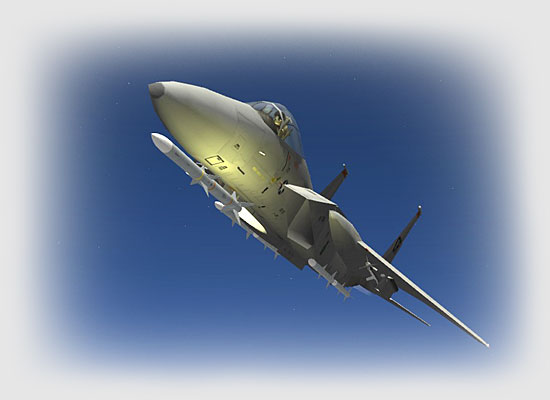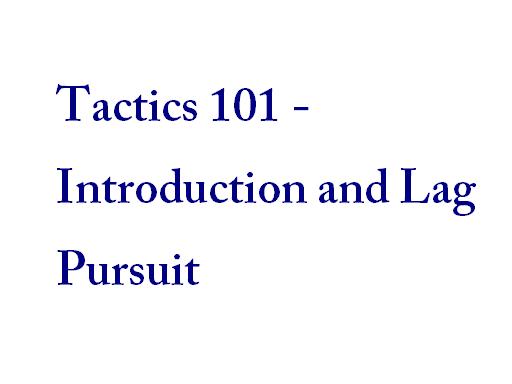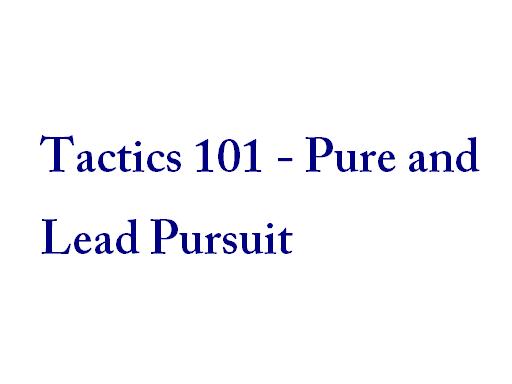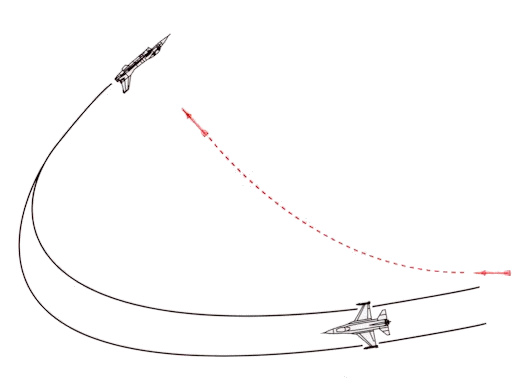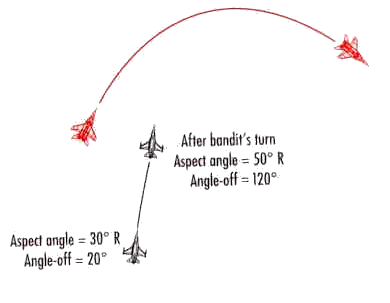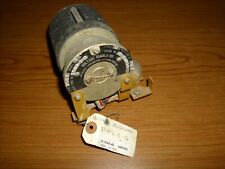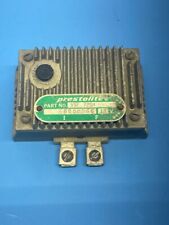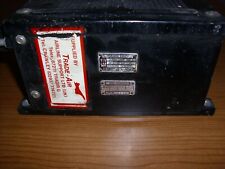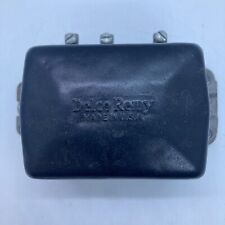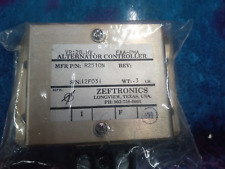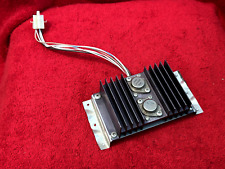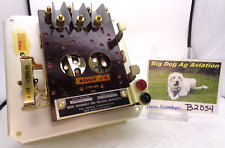by Ed “Skater” Lynch
For those of you that are “old salts” when it comes to flight sims, and for those of you that are new to flight sims, this article should be of some value to you. This is largely a reprint from the manual of one of the best combat flight sims ever released. Spectrum Holobyte’s Falcon 3.0 was indeed the father of all modern, “realistic” combat flight sims. The F3 manual was one hell of a paper weight. Weighing in at something like seven pounds, the F3 manual was jam packed with information on flying the sim, and the usage of tactics, and the deployment of weapons and the employment of the aircraft. Here is a little jewel from the tactics section. Enjoy!
Credit goes to Microprose / Hasbro Interactive, Spectrum Holobyte, and the Falcon 3.0 team.
Introduction to the Geometry of Air Combat
In order to become a great fighter pilot, you must perform great BFM. Now, in order to perform BFM, a fighter pilot must understand his positional relationship to the target from three perspectives: positional geometry, attack geometry and the weapons envelope.
Positional Geometry
Angle-off, range and aspect angle are terms used in BFM discussions to describe the relative advantage or disadvantage that one aircraft has in relation to another.
Angle-Off
Angle-Off is the difference, measured in degrees, between your heading and the bandit’s. This angle provides information about the relative fuselage alignment between the pilot’s jet and the bandit’s. For example, if the Angle-Off between you and a bandit were 0°, you would be on a parallel heading with the bandit, and the two fuselages would be aligned. If the angle-off were 90°, your fuselage would be perpendicular to the bandit.
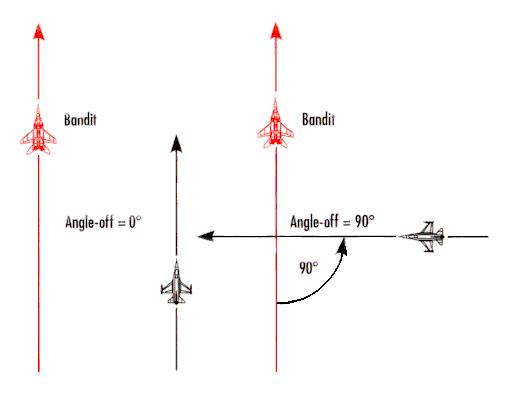
Range
Range is the distance between your jet and the bandit. In most HUD’s, range is measured in feet, out to one nautical mile (6,000 feet). Outside one nautical mile, range is measured in miles and tenths of miles. For example, a range to the target of 9,000 feet would be displayed as 1.5 nautical miles.
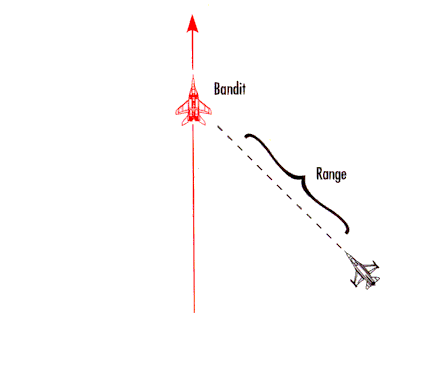
Aspect Angle
Aspect angle is the number of degrees measured from the tail of a target to your aircraft. Aspect angle is important because it indicates how far away your aircraft is from the target’s 6 o’clock position. Aspect angle has nothing to do with your heading. Note that the aspect angle stays the same, regardless of which way your aircraft is heading. Along with a measure in degrees from the target’s tail. In order to determine if the angle is left or right aspect, start at the target’s 6 o’clock facing the target. If your aircraft is in the right hemisphere, you have right aspect; in the left hemisphere, you have left target aspect. Aspect angle is important because, if you know the aspect angle and range to the target, you then know his lateral displacement or turning room from the target-and lateral displacement is very important in BFM.

Attack Geometry
Attack geometry describes the path that the offensive fighter takes as he converges on the bandit. When you start an attack on the bandit, there are three distinct paths or pursuit courses you can follow. These pursuit courses are lag pursuit, pure pursuit and lead pursuit. If you are pointing your aircraft behind the bandit, you are in lag pursuit. If you are pointing directly at the bandit, you are in pure pursuit. If you are pointing in front of the bandit, you are in lead pursuit.
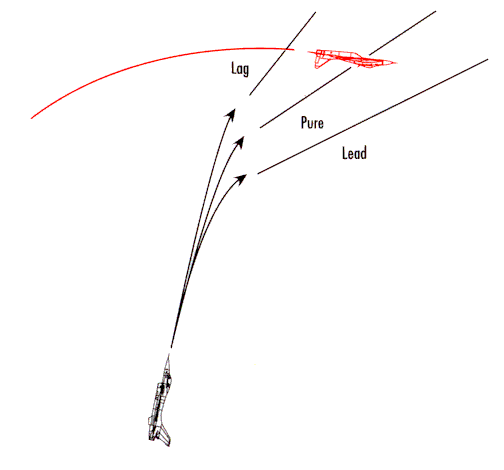
Lag Pursuit
Lag pursuit is used primarily on the approach to the bandit. Lag is also used any time an attacking fighter maneuvers out of plane (that is, not in the same plane of motion as the fighter under attack). You must have the ability to out-turn the bandit in order to fly lag pursuit for any length of time. The reason? In order to shoot a missile or the gun at the enemy, you must pull your nose out of lag. If the bandit can turn at a higher rate, he can keep your nose stuck in lag and keep you from shooting him.
Pure Pursuit
Pure pursuit is used to shoot missiles at the enemy. Flying a pure pursuit course all the way into the bandit will lead to an overshoot. For this reason, you should only point at the bandit when you are going to shoot. This image shows how holding a pure pursuit course will lead to an overshoot.
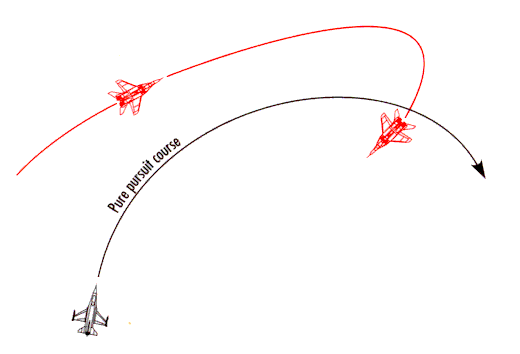
Lead Pursuit
Lead pursuit is used to close on the bandit and is also used for gun shots. Flying a lead pursuit course is the fastest way to get to the bandit because you cut him off in the sky. The problem with establishing a lead pursuit course too early is that you will overshoot the bandit when you get in close unless you have a significant turn rate advantage. If you are fighting a similar aircraft, such as the MiG-29, you will not normally be able to stay in lead and will be forced into an overshoot. It is important, however, to establish lead pursuit at the proper time in the fight because it is the only way that you can get into the gun envelope.
Determining the Pursuit Course
If the attacker is in the defender’s plane of motion, the velocity vector of the attacker determines the pursuit course.

The velocity vector, for the sake of our discussion, is the nose of the aircraft and represents the direction that your jet travels through the air at any given time. From the cockpit, the velocity vector is depicted by the flight path marker.
What if the attacker is not in the same plane of motion as the defender? How do you determine the pursuit course for out-of-plane maneuvering? When the attacker is not in the same plane as the defender, pursuit course is deter-mined by the lift vector of the attacker. An aircrafts lift vector is simply a vector that sticks directly out of the top of the jet, perpendicular to the aircraft’s wings. At high G, an aircraft moves along its lift vector. You position the lift vector by rolling, and when you pull G’s, the nose of the jet tracks toward the lift vector. The image below shows a fighter’s lift vector.

If an attacker pulls out of plane with a bandit, his pursuit course is then determined by where his lift vector is taking him. When the attacker pulls out of plane with a bandit, he is, by definition, flying lag pursuit. As he pulls back into a bandit, he may be flying lag, pure or lead pursuit, depending on the geometry of the fight. (The image below does not show a recommended maneuver but rather illustrates the effect of out-of-plane maneuvering on the pursuit course.)
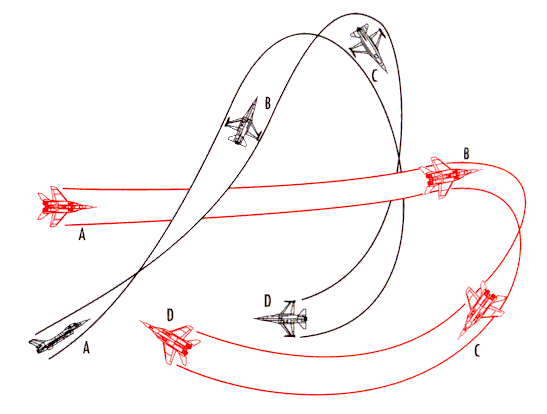
In this image, the F-16 immediately goes to lag pursuit when he pulls his nose out of plane in position B. At the top of this maneuver, he initiates a pull back down into the defender at position C. In this position, the F-16 is in pure pursuit. Notice at position D, when the F-16 enters the MiG-29’s plane-of-motion, his nose is on the Fulcrum and he is again flying a pure pursuit course.
Where you position the nose of the aircraft is very important when a pilot attacks the bandit. The use of attack pursuit geometry will be explained later on in detail, and we will talk in specific terms about where to place the jet in relationship to the bandit. For now, just make sure you understand what each of the pursuit courses are and what they do for you.
The Weapons Envelope
The weapons envelope is the area around the bandit where your missiles or gun can be effective. The weapons envelope is defined by angle-off, range and aspect angle. The dimensions and position of this area are dictated by the type of weapons you are carrying.
If your jet is loaded with all-aspect AIM-9M’s or AIM-120’s missiles, the area around the bandit looks like a doughnut; the outside ring being maximum range (Rmax) and the inside ring being minimum range (Rmin). With each missile, Rmax and Rmin are different. Generally speaking, missiles that have a greater range or Rmax also have a greater minimum range or Rmin.

Notice the oval shape of the all-aspect missile envelope. More of the area is in front of the bandit than behind him because a missile fired at high aspect on a bandit (that is, from in front), has a greater effective range than a missile fired at low-aspect (from behind). If you shoot a missile head-on at a bandit, the mere fact that the bandit is flying towards you will help the missile reach its target. The missile may actually fly a shorter distance to hit the bandit head-on than if it were fired at the bandit’s six. However, the range at which you first launch the missile will be greater, and this is what is important. The farther away you can launch a missile on the bandit and still have that missile be effective, the better. Always strive to get maximum performance out of your weapons. Another way to increase a missile’s effective range is to launch at a significantly higher altitude than the bandit. This will give your missile a reserve of potential energy that it can convert into kinetic energy.
As a target pulls G’s, the weapons envelope shifts. Generally, the limits of Rmax and Rmin in front of the aircraft both move out in the direction of the turn, while Rmax and Rmin behind the aircraft move in on the belly side of turn. The next image shows a target in a 5 G turn. The important point to remember is that a bandit that is in fear of dying will turn into you at high G. When this happens, Rmin expands outward from the target at a rapid rate, and within seconds you may be inside minimum range for a missile shot.

For Guns
The gun is different from missiles in that it has no minimum range. The gun weapons envelope is a circle around the bandit depicting the gun’s maximum range. There is no minimum range circle.
Remember, a fighter pilot must be aware of where he is at all times in respect to his weapons envelope.
The geometry of the fight is important. You should understand the principles and terms covered on this page in order to become a good pilot.
Part Two: Introduction to Offensive BFM
Part Three: Introduction to Defensive BFM


